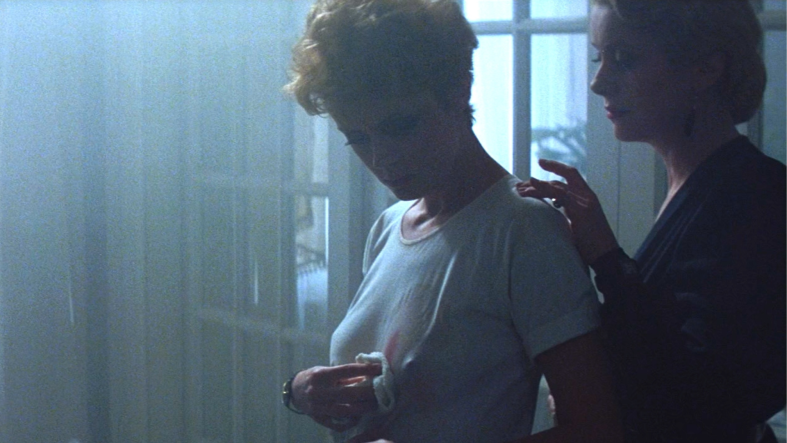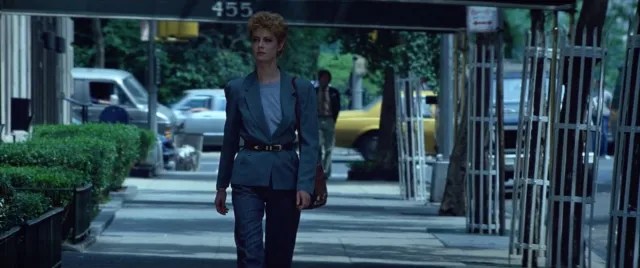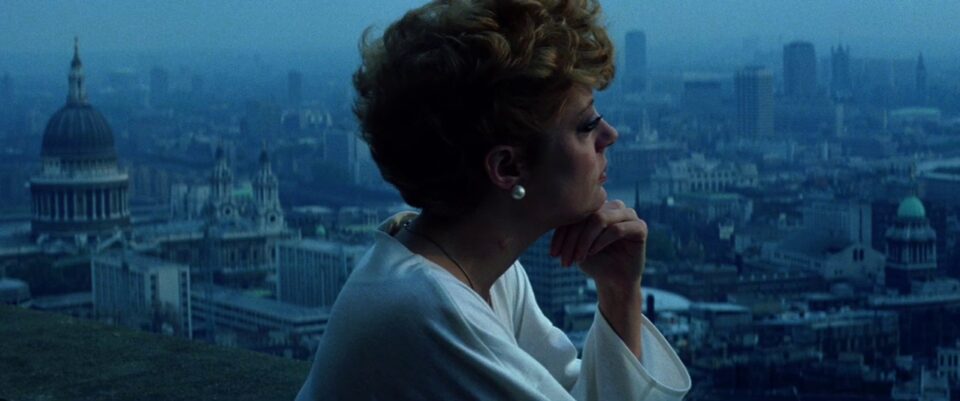How ‘The Hunger’ Queered Vampire Style [FINAL GIRL FASHION]

“Bela Lugosi’s dead!“
That’s one of the first phrases uttered in The Hunger (1983). Sung by the lead singer of Bauhaus, it is a line from the famous song of the same name, the one that many of us have permanently added to our Halloween party playlists. It also serves as a perfect summary of how this film deconstructs traditional vampire iconography and then resurrects it, this time as unquestionably queer.
It’s impossible to talk about Tony Scott’s The Hunger without talking about its fierce sense of fashion. With costumes designed by Academy Award winner Milena Canonero (A Clockwork Orange, The Shining), select pieces provided by Yves St. Laurent and Manolo Blahnik, and two timeless icons of glamour (David Bowie and Catherine Deneuve) rounding out its cast, this movie practically bleeds beauty. But despite what critics said upon its release, the film is not just a winning example of style over substance. Rather, its style provides its substance, reworking our expectations of an often stereotypical subgenre while also providing insights into its leading ladies’ motivations and predilections.
THE FEMME FATALE
The Hunger poster art suggests that the film is equal parts Bowie, Deneuve, and Susan Sarandon. But the latter two are the true stars of the picture, their characters telling unique stories by way of how they adorn their bodies.
Sure, Bowie’s character, the lovesick and slowly dying John, is fashionable in his own right. But his clothing doesn’t say much more than this is a man who has learned to thrive with the times. Meanwhile, Deneuve’s Miriam Blaylock spells out her character’s entire personality and history through her choices in wardrobe.
Miriam has been a vampire for centuries, a fact illustrated through flashbacks that show her at different points throughout her extended lifetime. But in each era, she remains dedicated to femininity, or at least the womanly styles of the given time period. Through this overtly gendered dress, she has been able to navigate so many different versions of society without detection.
In the main timeline of The Hunger, Miriam presents as a high femme goth, always appearing as though she’s dressed for an expensive funeral. While the silhouettes of her suits can be harsh, she accents her looks with ladylike accessories, including bold blush, ornate brooches, cat eye sunglasses, and dramatic, pearl-adorned veils. Oh, and you’ll never catch her without high heels on. The same goes for her gold ankh pendant, which serves more than just a superficial purpose as it hides the mini dagger she uses to slice open strangers.
In a way, Miriam is both out of time and in fashion. Her signature style feels equal parts art deco retro and new wave chic. She stands out in whatever room she’s in, allowing her to glamour strangers without using her immortal impulses. It’s no wonder she’s been able to seduce multiple companions over the years, drawing them into her deeply disturbing world until she’s ready to move on to the next willing victim.

BEHIND THE MASC
Miriam’s newest conquest, Dr. Sarah Roberts (Sarandon), is almost the opposite of her in terms of presentation. Much more future-facing, Sarah mixes casual touchstones (think white t-shirts) with formal wear (standout blazers). And while she’s not afraid to wear a skirt, Sarah is almost always in pants. This fact, along with short hair, establishes her as a more overtly masculine presence, or at least a gender-defying one.
In this way, Sarah is more like John than Miriam, which is perhaps what makes her so attractive to the haute couture-hawking ice queen in the first place. But unlike John, who quite literally crumbles after he begins aging, Sarah is independent in thought and action. A working woman with a new book on the promotional circuit, she projects genuine confidence, making her both a perfect match and natural foil for the manipulative and narcissistic Miriam.
Yes, Sarah goes to bed with Miriam in one of the sexiest scenes in cinematic history, leading to her slow transformation into a vampire. But Sarah also tricks the trickster, using Miriam’s signature necklace against her in the film’s blood-drenched climax. While John begs for death after finding out eternal life does not always equal eternal youth, Sarah takes matters into her own hands by attempting to kill herself before it’s too late.
After the perceived loss of Sarah (and a showdown with her other former lovers), Miriam finally shows her age. Her previously perfect skin decays in front of our eyes just as John’s did in the first act of the film. No longer able to hide behind her feminine wiles and designer duds, she fades into obscurity.

DEATH TO GENDER
The final scene of The Hunger is a controversial one, with Sarandon herself stating that it muddies the message of the film in an effort to leave room for a sequel. It is here that Scott reveals that Sarah, previously presumed dead, is still kicking. In fact, the good doctor is living a life of endless luxury with lovers of various genders, while Miriam continues to rot in a box. Oh, and she’s still got that ankh necklace, donning the symbol of immortality around her neck like a medal of honor.
I understand why many folks take issue with this final moment. But when you look outside of the film, it feels significant, as if Scott and Canonero were signalling the start of a new era for a beloved, yet antiquated subgenre.
While studio films released before The Hunger (say, you know, the ones starring Bela Lugosi) focused mainly on bloodthirsty men in capes hunting women for sport, this one flipped this tired trope on its head in every sense. In doing so, it opened the casket for many fashion-forward vampire films and series to come, including the equally subversive The Lost Boys, Interview with the Vampire and Buffy the Vampire Slayer. And in this fresh and unfettered day and age, you can dress, fuck and suck as you please.
Categorized:Editorials Final Gril Fashion

